Legend, 2009
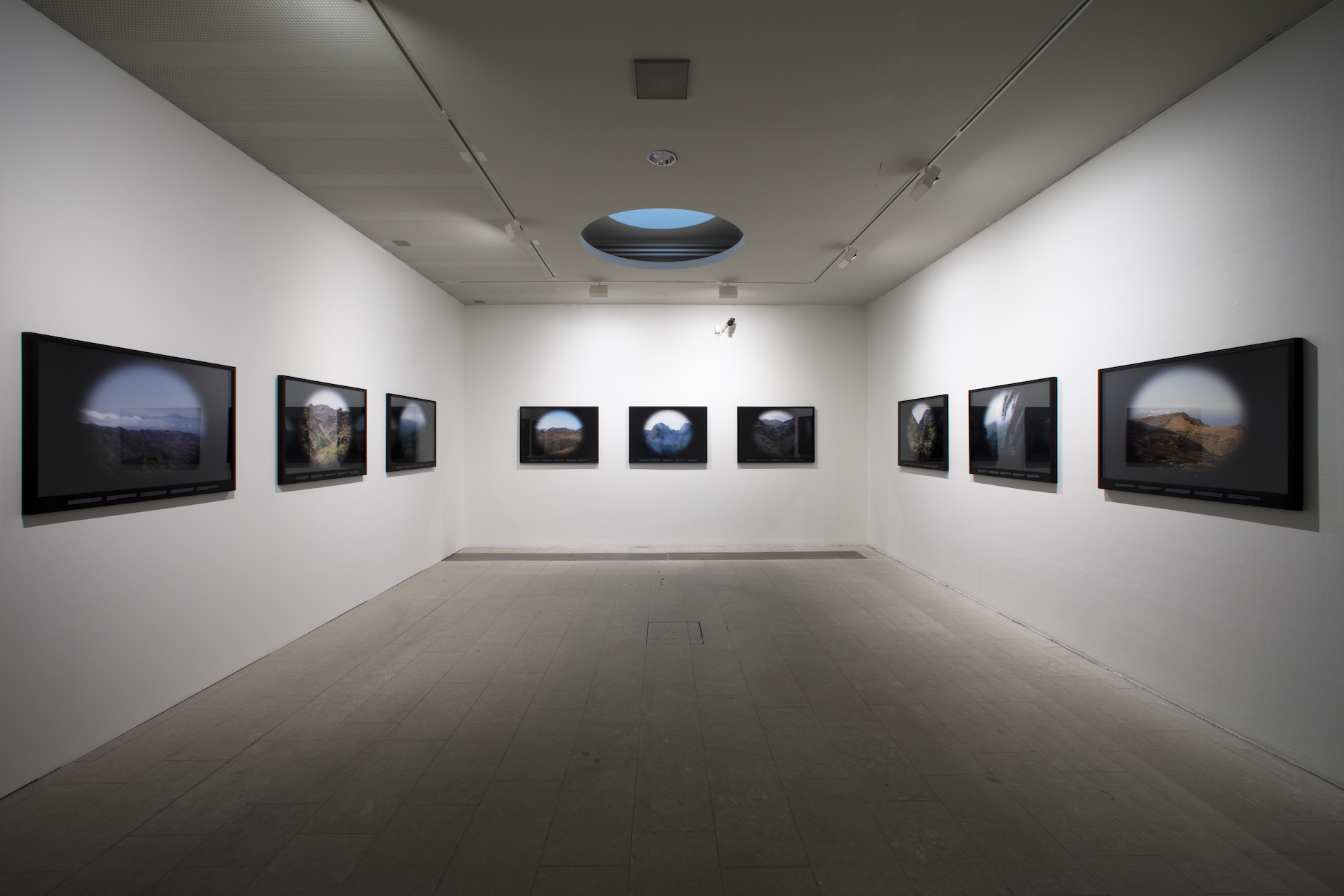
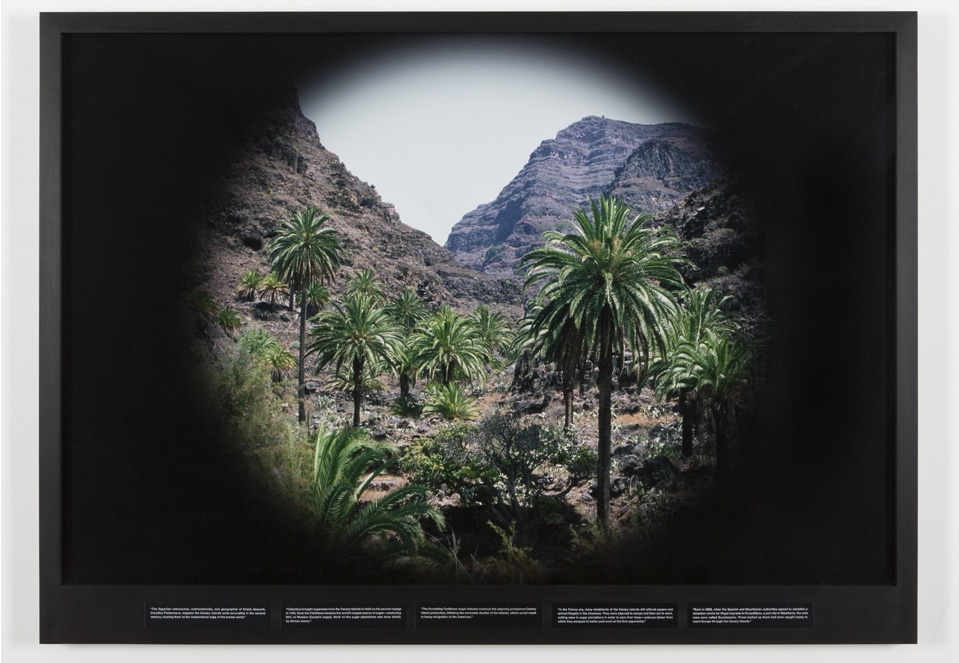


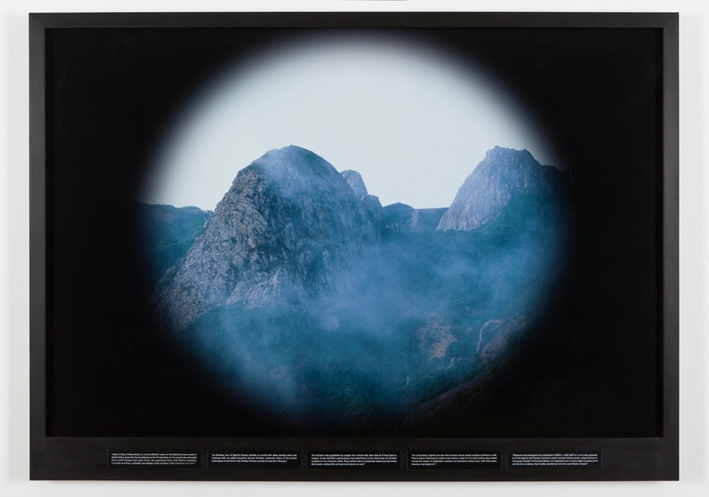
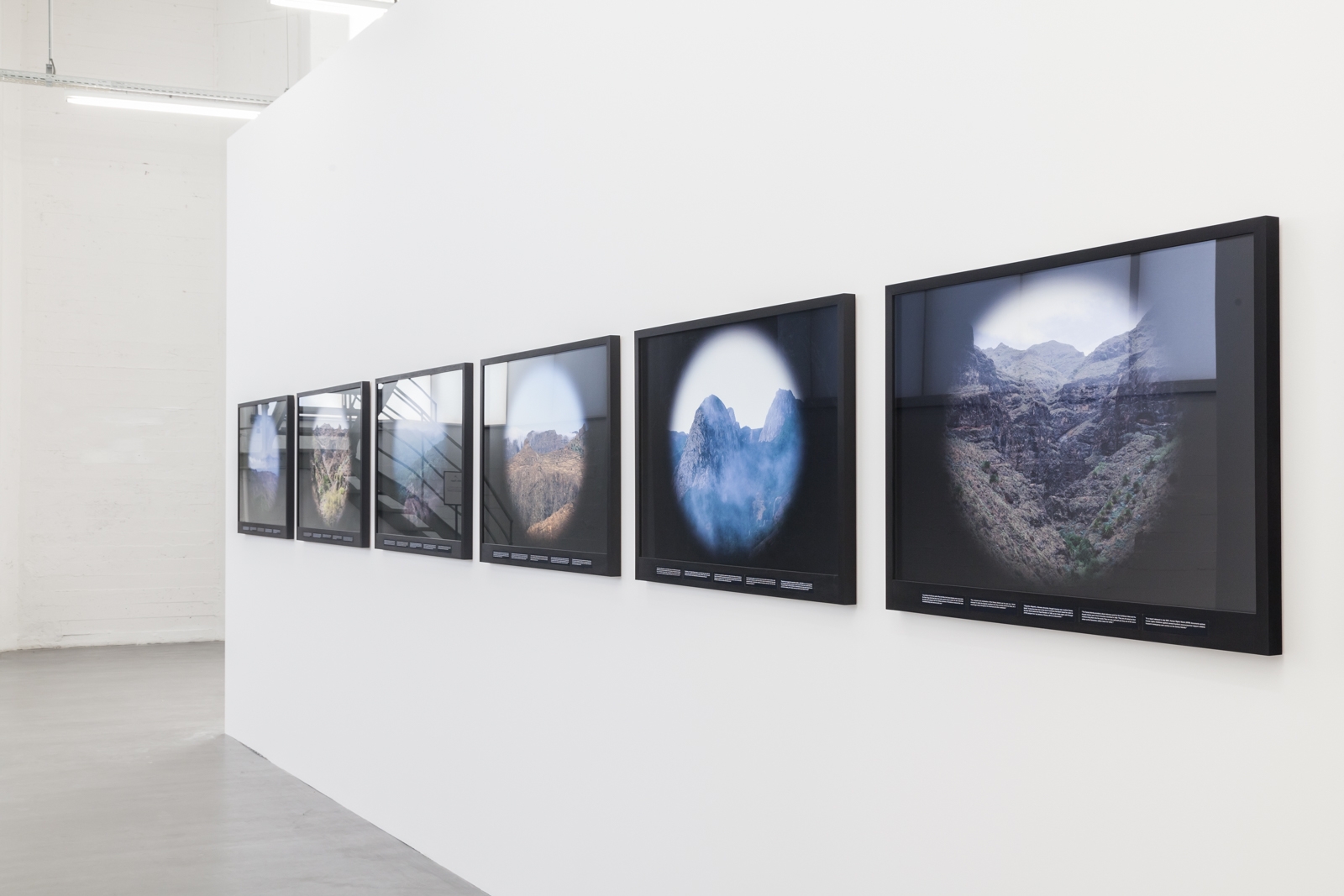

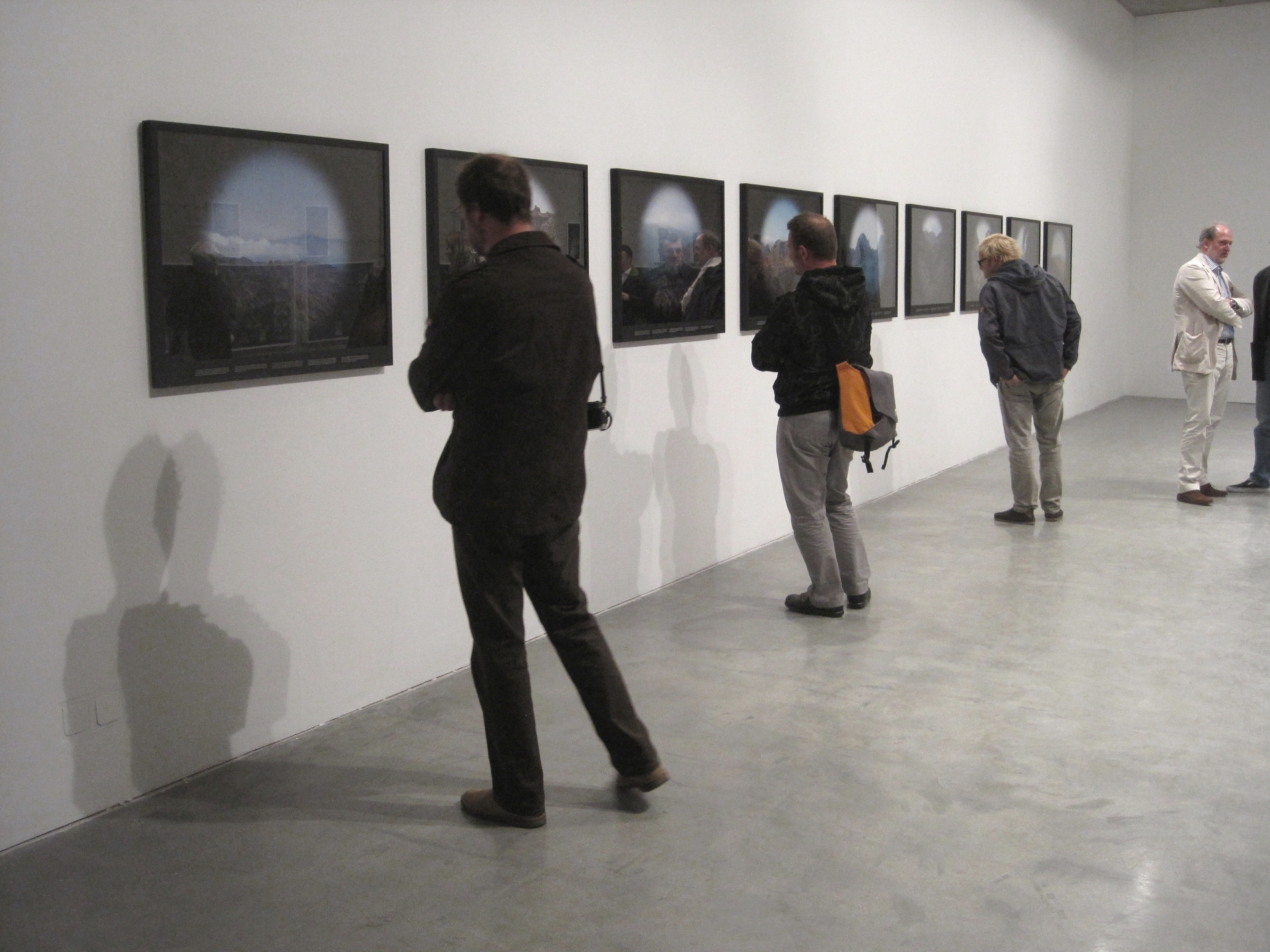


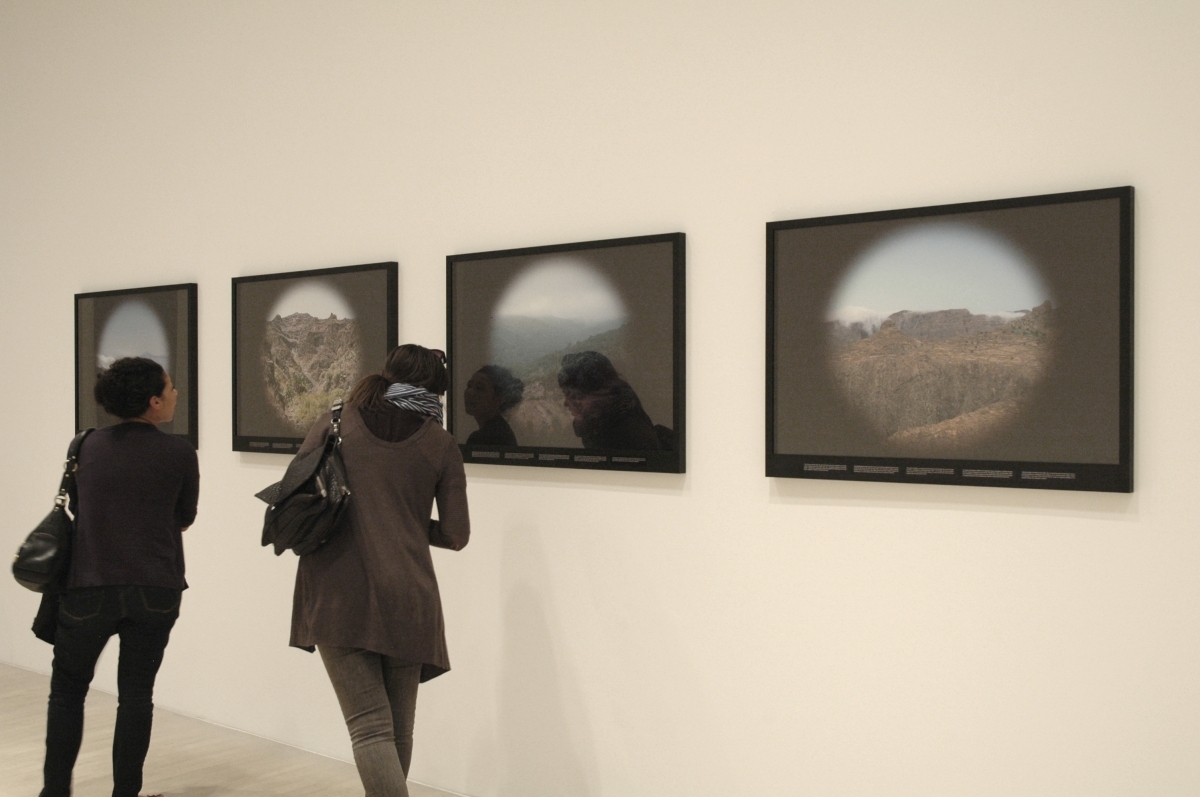

Distant Voices, Distant Views
“In 1758, the Swedish natural historian Carl Linnaeus named the olive-green songbird Serinus canaria for its native home, the Canary Islands. The tiny bird had become a popular pet in Europe since Spain conquered the islands. Often arriving in European ports with sugar, Spain’s main export product, they were also called sugarbirds.”
(from a “caption” in “Legend”, 2009)
For her photographic installation Legend, 2009, Ana Torfs traveled to the island of La Gomera in the Atlantic Ocean. As the second-smallest of the seven Spanish Canary Islands, this volcanic isle is located off the Northwest coast of North Africa.
The act of traveling as a physical and mental movement and the experience and perception of a place are important issues in Ana Torfs’ work, and this installation may be taken as a highly concentrated, and focused, involvement with a special place. The nine photographs for Legend were all taken on the island. Given their ample landscape format, they almost suggest a cinematic view. Evenly installed in a row on the wall, they invite the viewer to deliberately pace them off, were it not for the small-printed texts accompanying the photographs.
As he necessarily comes closer to read these texts, the viewer will discover that the letters are not actually printed, but (laser-) engraved in separate anodized aluminum tags: one engraved tag for every paragraph, and five paragraphs/tags for every image, placed horizontally beneath the image and embedded in the wooden frames.
The combination of photography with text is a familiar artistic practice not just since Conceptual Art’s fathoming of the semantics of image and word. Yet, the material quality of this constellation in Legend provides further semantic strata that enrich the work’s overall subject.
The artist herself has stated the different meanings of the word “legend”, denoting both “a story coming down from the past whose truth is popularly accepted but cannot be checked” (as the dictionary puts it), and the verbal part in combination with an object or an image, be it a writing or a title on an object, a caption, or an explanatory list of the symbols on a map or chart.
Both definitions of the title thus relate to the work’s form and content, with the written captions accompanying the photographs as with the “stories from the past” they tell (which will be referred to later in the text).
However, the word’s etymology seems to be no less fundamental for the artist, and for an understanding of the work. Again, Ana Torfs provides knowledge of the term’s history, pointing out to its derivation from the Latin word “legere”, which signifies “to gather, select, read”.
With this in mind, the unusual materiality of the “captions” or “legends” under the photographs takes on a special meaning. Their separate arrangement in isolated, embedded tags emphasises their heterogeneous origins. The different “stories” they tell are all “gathered” and “selected” from different narratives and sources, yet they all refer to the same subject–to La Gomera, and in a wider sense, to the whole archipelago of the Canary Islands as a group with a connected history. The labels present these stories as if in a museum, displaying the findings of a natural scientific expedition.
‘Accumulated’ as they are, the legends also stand for the cultural heritage that forms the Canaries’ history. In that, it seems just logical that the tags are nevertheless meticulously set in the wooden frame; they adapt the same (quasi-volcanic) colour and seem almost organically connected with it. These tags are part of the image’s frame just as much as the stories they tell are framing our knowledge, and perception of, the islands.
This interaction of what we see and what we know, what we think and what we feel,—and what we believe—,when we are confronted with a place (and its hidden history) or a story has been an ongoing topic in the work of Ana Torfs. Just as much, the very act of seeing and perceiving is an issue that she constantly reflects upon in her practice, and Legend quite evidently testifies to this concern.
In this work, the viewer’s gaze is framed and focused on La Gomera’s surface. Taken from an elevated standpoint, the photographs show the incredible variety of the island’s geology and vegetation, from the “arid, desert-like south […] to the moist forest slopes of the central highlands”, as one legend reads: we see rocky hillsides and Mediterranean palms, densely wooded valleys and fog shrouded peaks.
The vignetting of the photographs alludes to early photography and film, and implies that the image centre shows a ‘hot-spot’ of special relevance; yet, no visual action takes place. Rather, visibility itself is in the focus of the image, as the motifs play with historical conventions of seeing and perceiving: The low saturation of the photographs’ colours intimates the colourized prints of the 19th century, a time when the meditation on stereoscopic images of long-distance journeys stood for social entertainment and the act of taking (visual) possession of the Other. The scopic view through a telescope or a camera was (and is), in this sense, always a powerful, colonizing one.1
That visibility is more a cultural ‘dispositif’ than a natural fact has been widely discussed following Foucault’s “Discipline and Punish”. The question of seeing and being seen depends on social conventions and technological possibilities much more than on an individual’s will.2 What we see is highly formatted, as the vignetting also indicates: Taken from the distance, the photographs provide a telescopic view, and while it would have been the prospect from an expeditionary ship sailing off the island’s shore in earlier times, today’s viewing habits more readily suggest the technical eye of a surveillance camera.
The ‘objective’ distance of the view corresponds with the neutral tone of the legends. The texts were taken from different sources and convey a dense and compact rhetoric. The five captions for each of the nine photographs refer to different histories and cultural, scientific and political contexts of the archipelago’s past and present. Repeatedly, mythological accounts are quoted, emphasizing the Canaries’ fabled location at the “westernmost edge of the known world” in ancient times, continued in descriptions of La Gomera’s site as the starting point for Columbus’ voyage to the New World, the Canaries’ inglorious ‘pioneering’ role under Franco’s military dictatorship, and their use as a gateway to Europe for thousands of illegal immigrants each year–it is only since 2008 that the new satellite system “Sea Horse” tracks immigrant vessels and thus inhibits further immigration.
Repeatedly, the hints to the archipelago’s conquest echo the discovery of the New World, as this caption suggests:
The conquest and colonisation of the Canary Islands can be seen as a ‘dress rehearsal’ in which the Spanish practised what they actually performed later, on a much larger scale, throughout the Americas and other continents.
Accounts on the Canaries’ extreme variety of species in animals and plants, its population history, scientific discoveries, and many more aspects, are added, thus creating a multifarious meshwork of references discursively ‘encompassing’ the islands just like the visual vignetting in the photographs. At the same time, the interweaving of the legends also recounts the many movements back and forth, to and fro the island, of expeditions and emigrants swarming out, of conquerors and immigrants landing, of different layers of ‘inhabitants’ and visitors, and the mythic images of them:
“According to the Roman author Pliny the Elder, the Canary Islands were named after the fierce dogs that lived there (the Latin word for dog is canis). He also wrote that the isles were plagued with the rotting carcasses of monstrous creatures that were constantly being cast ashore by the sea.”
“La Gomera was populated by people who talked with their lips as if they had no tongue. It was said that a great prince had exiled them to the island and cut off their tongues for an unknown crime. They walked about completely naked and ate herbs like beasts, eating dirty animals and insects as well.”
Accompanying the deserted landscapes of the photographs, the texts give a highly animate impression of archipelago’s history and present, calling to mind that a story of conquest is always also a story of repression and loss.
Given the long literary tradition of the Sea as a narrative space, as exemplified in the epics of the Odyssey, Sindbad the Sailor, and others, it seems more than apt to literarily weave such a meshwork of stories and tales around a group of Atlantic islands, even more so the history-charged “Fortunate Isles”, the “Earthly Paradise” and “Elysian Fields”, or the “Purple Islands”, as the Canaries have been dubbed throughout the centuries.
And again, as in other works such as “Displacement” (2009), it is Ana Torfs’ precise selection of image and text that creates a powerful narrative. The Canary Islands might well be a particularly rewarding subject for the artist’s investigation of a place’s semantics and psycho-emotional potential. Yet, her mode of visually and verbally reducing and condensing a given data unfolds a highly complex account and thus reminds us, generally, of the fact that what we (superficially) see is often much less than we actually get.
Kassandra Nakas[1] Geoffrey Batchen discusses the historical coincidence of the conception of photography and the invention of the panopticon, as a technique of surveillance, in early 19th century in: id., Guilty Pleasures, in: Th. Levin, U. Frohne, P. Weibel, eds., CRTL [Space]: rhetorics of surveillance from Bentham to Big Brother, Karlsruhe 2002, pp. 447-459.
[2] For a recent discussion of this topic see Dietmar Kammerer, Bilder der Überwachung, Frankfurt a. M.: Suhrkamp, 2008, esp. pp. 103-142.